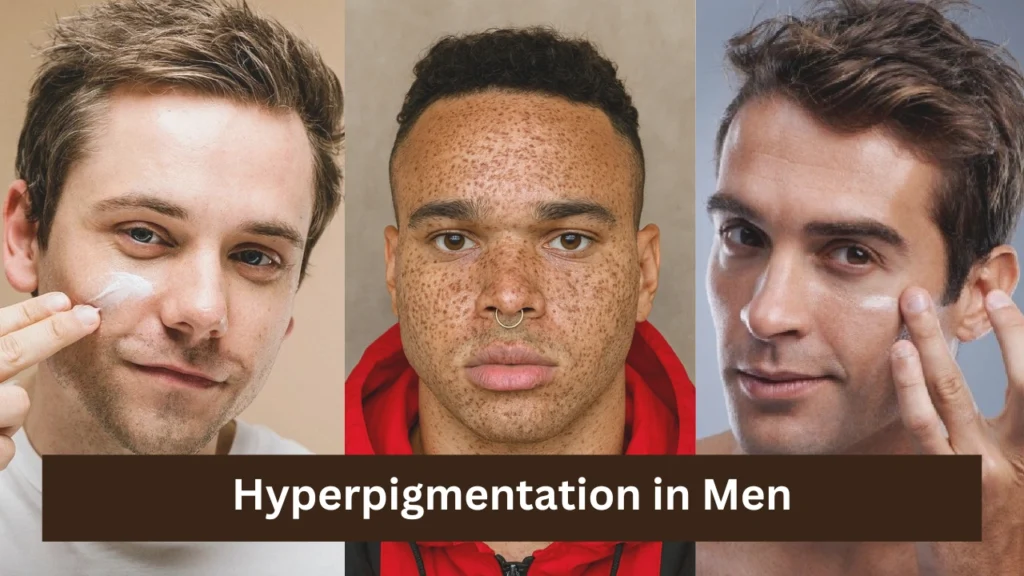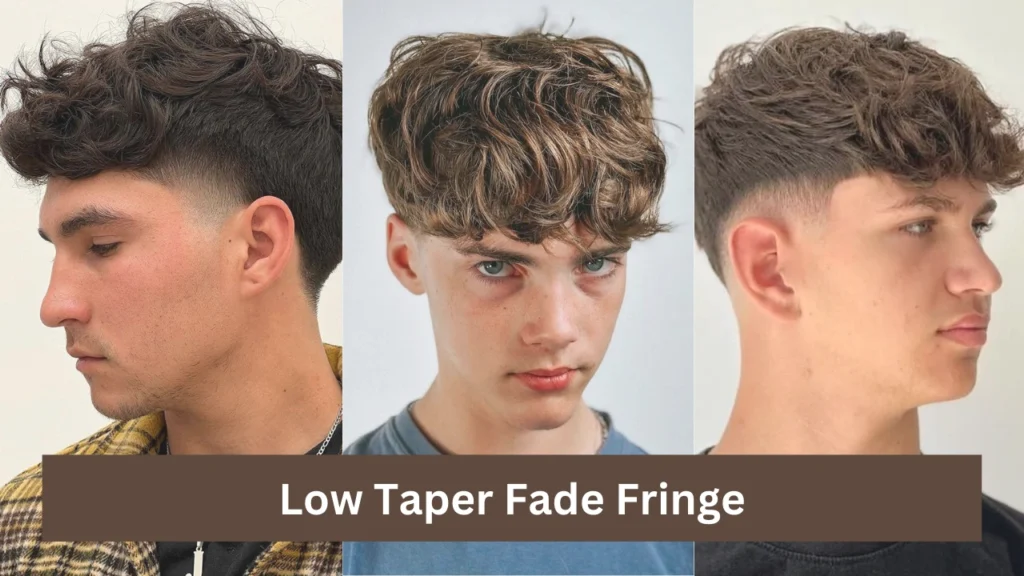Hyperpigmentation
Hyperpigmentation in men is an increasingly common skin concern that affects men of all ages and skin tones. Whether it appears as hyperpigmentation dark patches on face male, or more specific issues like hyperpigmentation around mouth in men, it can impact confidence and self image.
Understanding what causes hyperpigmentation in men is the first step toward effective prevention and treatment. Factors such as sun exposure, shaving irritation, acne scarring and even hormones can play a role; with hormonal hyperpigmentation in men and post inflammatory hyperpigmentation in men being frequent culprits. In darker skin tones, hyperpigmentation in black men can appear more pronounced due to higher melanin levels.
This article explores the causes of hyperpigmentation on face in men, whether testosterone causes hyperpigmentation and how to treat hyperpigmentation in men using the right skincare habits and scientifically backed solutions.
What Is Hyperpigmentation in Men?
Hyperpigmentation refers to areas of the skin that appear darker than the surrounding skin due to an overproduction of melanin, the pigment responsible for skin color. In men, these dark patches often appear on the face, neck, shoulders, back, or even hands. The condition itself is harmless but can lead to uneven skin tone and affect self esteem.
Men’s skin tends to be thicker and oilier than women’s, which makes it both resilient and prone to post inflammatory pigmentation; especially from shaving or acne. Understanding how and why this occurs is key to finding the right treatment and preventive routine.
Root Cause of Hyperpigmentation in Men
The root cause of hyperpigmentation in men can vary based on lifestyle, genetics and external exposure. Here are the major factors contributing to this condition:
1. Sun Exposure
The leading root cause of hyperpigmentation in men is prolonged sun exposure. Ultraviolet (UV) rays stimulate melanocytes; the pigment producing cells in the skin, to release excess melanin as a defense mechanism. Over time, this results in dark spots, freckles, or tanning that becomes difficult to fade.
2. Post Inflammatory Pigmentation (PIH)
Men who suffer from acne or regularly shave are more susceptible to post inflammatory hyperpigmentation. Every time the skin becomes irritated; whether due to pimples, razor burns, or cuts; it triggers inflammation that leaves behind darker marks even after healing.
3. Hormonal Imbalance
Although hormonal pigmentation (like melasma) is more prevalent in women, men are not exempt. Elevated testosterone or thyroid related changes can occasionally trigger pigmentation on the forehead, cheeks, or around the nose.
4. Genetics
Some men are genetically predisposed to producing more melanin. Those with darker skin tones naturally have a higher chance of developing pigmentation, especially when exposed to sunlight.
5. Environmental Factors
Pollution, smoking, alcohol consumption and poor sleep habits can all contribute to oxidative stress, which accelerates skin cell damage and leads to hyperpigmentation.
Types of Hyperpigmentation in Men
Men experience different types of hyperpigmentation, each caused by unique factors such as sun exposure, inflammation, or genetics. Understanding which type you have helps determine the most effective treatment approach.
1. Sunspots (Solar Lentigines)

These are flat, dark brown spots that appear on sun exposed areas like the face, neck and hands. Prolonged UV exposure overstimulates melanin production, leading to visible patches.
Treatment: Daily sunscreen, vitamin C or niacinamide serums and occasional chemical peels or laser therapy for stubborn spots.
2. Post Inflammatory Hyperpigmentation (PIH)
Common in men with acne or razor irritation, PIH appears as brown or bluish marks after inflammation or injury.
Treatment: Gentle exfoliation, retinoids, azelaic acid, or niacinamide. Avoid harsh scrubbing or frequent shaving on affected areas.
3. Melasma
Characterized by symmetrical brown or grayish patches on the cheeks, forehead, or nose. While less common in men, it’s often triggered by UV exposure, stress, or hormonal imbalance.
Treatment: Consistent sun protection, hydroquinone creams, kojic acid and dermatologist guided chemical peels or lasers.
4. Freckles
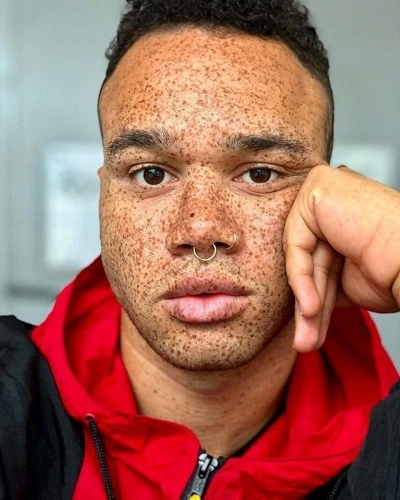
Small, light brown spots that darken with sunlight. Freckles are usually genetic but can increase with unprotected sun exposure.
Treatment: Daily SPF 30+, vitamin C and laser treatments for those wanting to fade them.
5. Shaving Related Pigmentation

Frequent shaving, especially with dull razors, can cause irritation, razor bumps and dark patches around the jawline or neck.
Treatment: Use sharp razors, soothing aftershave and mild chemical exfoliants like glycolic acid to even skin tone.
Each type of hyperpigmentation in men has a different root cause and requires a tailored approach. With the right products, consistent treatment and sun protection, men can significantly reduce dark spots and maintain a clearer, more even complexion.
Treatment for Hyperpigmentation in Men
The right treatment for hyperpigmentation in men depends on its severity, cause and duration. Dermatologists typically recommend a mix of topical medications, cosmetic procedures and consistent skincare habits.
1. Topical Treatments
- Hydroquinone: A dermatologist prescribed bleaching agent that reduces melanin production.
- Retinoids (Retinol, Tretinoin): Help increase cell turnover and lighten dark patches gradually.
- Vitamin C: A potent antioxidant that fades spots and protects against future sun induced pigmentation.
- Niacinamide: Balances oil production, brightens the skin and strengthens the skin barrier.
- Alpha Arbutin and Kojic Acid: Natural brighteners that work gently on uneven skin tone.
Using a combination of these active ingredients over several weeks often results in noticeable improvement.
2. In Clinic Dermatological Treatments
For deeper pigmentation, professional treatment options may be more effective:
- Chemical Peels: Use acids like glycolic or lactic acid to remove the top pigmented layer.
- Laser Therapy: Targets deeper pigmentation with precise light energy.
- Microdermabrasion: Gently exfoliates the outer layer to reveal new, even toned skin.
- Microneedling: Stimulates collagen and aids in faster fading of dark spots.
Always consult a qualified dermatologist before undergoing these treatments, as improper use can sometimes worsen hyperpigmentation.
Best Products for Hyperpigmentation in Men
A consistent skincare routine with the right products is essential for reducing dark spots and preventing new pigmentation. Men should opt for non comedogenic, fragrance free and dermatologist tested formulations suitable for their skin type.
1. Cleansers
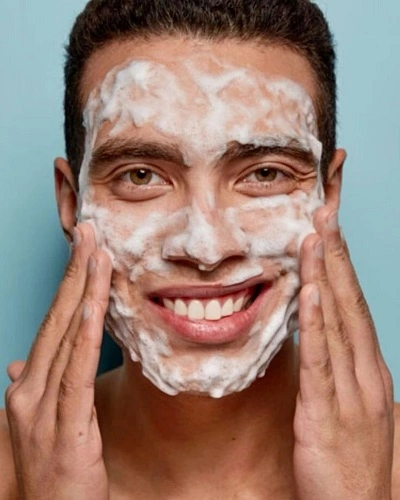
Start with a cleanser that removes dirt, excess oil and dead skin cells without over drying the skin.
- Salicylic acid helps unclog pores and control acne.
- Glycolic acid or lactic acid exfoliate the surface, fading dullness and uneven tone.
- Niacinamide soothes irritation from shaving and reduces redness.
Use morning and night to keep skin fresh and receptive to treatments.
2. Serums

Serums deliver targeted active ingredients that directly address hyperpigmentation.
- Vitamin C brightens the skin and protects against sun damage.
- Niacinamide minimizes inflammation and prevents new dark spots.
- Alpha arbutin and kojic acid gently lighten existing pigmentation.
Apply a few drops after cleansing and before moisturizing for best absorption.
3. Moisturizers
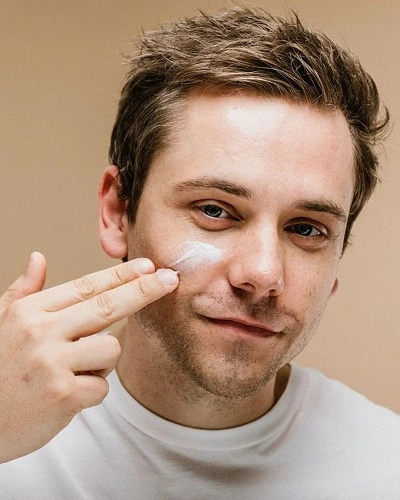
Hydration supports healing and keeps the skin barrier strong, which is vital for fading pigmentation.
- Ceramides and hyaluronic acid lock in moisture and smooth texture.
- Peptides encourage skin renewal.
- Aloe vera or green tea extract calm irritation and redness.
Choose lighter gels for oily skin and richer creams for dry or sensitive skin.
4. Sunscreen

The most critical step in treating hyperpigmentation in men is daily sun protection. UV exposure worsens existing spots and triggers new ones.
- Use a broad spectrum SPF 30 or higher.
- Zinc oxide or titanium dioxide formulas are ideal for sensitive skin.
- Opt for matte, lightweight, or gel based sunscreens that suit men’s skin texture.
Pro Tip: Apply sunscreen every morning as the last step in your routine and reapply every 2–3 hours if outdoors.
Home Remedies for Hyperpigmentation in Men
For men who prefer natural solutions or want to complement medical treatment, there are several safe and effective home remedies that can help.
1. Aloe Vera Gel
Contains aloin, a natural depigmenting compound. Apply fresh aloe gel to dark areas daily for calming and brightening effects.
2. Lemon Juice and Honey
Lemon acts as a mild natural bleach while honey soothes the skin. Mix equal parts and apply to affected areas for 10 minutes. Rinse thoroughly and follow with sunscreen.
3. Turmeric Mask
Turmeric has anti inflammatory properties that help reduce melanin synthesis. Combine turmeric powder with milk or yogurt and apply twice weekly.
4. Potato and Cucumber Extract
Both contain natural bleaching enzymes that can lighten dark areas with regular use.
5. Green Tea
Rich in antioxidants, green tea helps combat oxidative damage that leads to pigmentation. Dab cooled green tea onto dark spots daily for visible improvement.
While home remedies can support professional treatments, results are gradual and require consistent application.
Preventive Measures for Hyperpigmentation in Men
Prevention is always better than cure. Men can prevent pigmentation by following these simple yet powerful habits:
- Never skip sunscreen. Even indoor light can worsen pigmentation.
- Avoid picking pimples or scratching irritated skin.
- Use a clean razor and proper shaving cream to reduce razor burns.
- Eat antioxidant rich foods like berries, green tea and leafy vegetables.
- Stay hydrated; water supports healthy skin regeneration.
- Get enough sleep to allow the skin to repair overnight.
When to See a Dermatologist?
If hyperpigmentation in men persists for several months despite home care or over the counter products, it’s time to see a dermatologist. They can identify the precise root cause, assess the depth of pigmentation and recommend a personalized treatment plan.
Seek professional help immediately if:
- Pigmentation spreads rapidly.
- The affected area becomes itchy, raised, or painful.
- You suspect it’s linked to medication or hormonal changes.
Final Thoughts
Dealing with hyperpigmentation in men face doesn’t have to be frustrating or confusing. By identifying the root triggers; whether they stem from shaving irritation, acne scars, hormonal fluctuations, or excess sun exposure; you can make informed choices about how to treat hyperpigmentation in men safely and effectively.
The right approach often includes consistent skincare routines, professional treatments and using the best cream for hyperpigmentation in men suited to your skin type. Awareness is key: understanding what causes hyperpigmentation in men empowers you to protect your skin and maintain an even tone long term.
Whether you’re dealing with hyperpigmentation around mouth in men or broader hyperpigmentation dark patches on face male, remember that knowledge and care can make all the difference.
FAQs: hyperpigmentation in men
1. How to get rid of hyperpigmentation in men?
To treat hyperpigmentation in men, use brightening products with vitamin C, niacinamide, or retinol and always wear sunscreen daily. For faster results, dermatologists may suggest chemical peels, laser therapy, or microneedling. Consistency and sun protection are key.
2. What causes hyperpigmentation in men?
The main root causes include sun exposure, acne scars, shaving irritation, hormonal changes, genetics and pollution. UV rays and inflammation stimulate excess melanin, leading to dark spots or uneven tone.
3. Does low testosterone cause pigmentation?
Low testosterone doesn’t directly cause hyperpigmentation, but hormonal imbalances can influence melanin activity and make skin appear dull or uneven. Most pigmentation, however, comes from sun damage or irritation rather than hormones.
4. Can vitamin C remove pigmentation?
Yes. Vitamin C helps fade dark spots by blocking melanin production and protecting against UV damage. Regular use of a vitamin C serum under sunscreen can visibly brighten and even out the skin.
5. Can hyperpigmentation fully go away?
In many cases, yes. Surface pigmentation from acne or sun damage can fade with consistent skincare and treatment. Deeper pigmentation may need professional help, but results are achievable with patience and protection.
6. Can stress cause hyperpigmentation?
Yes, indirectly. Stress raises cortisol levels, which can trigger inflammation and increase melanin production. Managing stress and getting good sleep helps prevent dullness and uneven tone.
7. What is the quickest way to remove hyperpigmentation?
The quickest treatment involves dermatologist guided laser therapy, chemical peels, or prescription creams like hydroquinone. Pairing these with daily sunscreen and brightening serums gives faster results.
8. How to remove melasma in men?
To treat melasma, men should use products with tranexamic acid, retinoids, or hydroquinone, apply sunscreen daily and avoid heat or sun exposure. For stubborn patches, laser or peel treatments can help lighten discoloration.
